笔译期末复习
- 格式:doc
- 大小:47.00 KB
- 文档页数:6
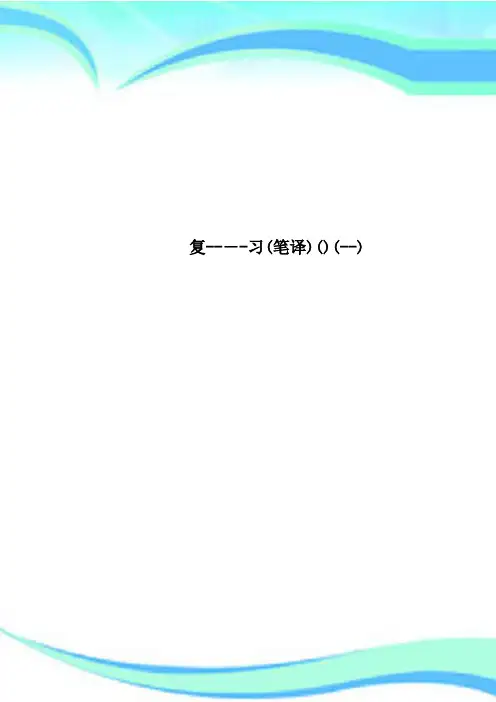
复----习(笔译)()(--)————————————————————————————————作者:————————————————————————————————日期:复习Unit 11.直译所谓直译,就是在译文语言条件许可时,在译文中既保持原文的内容,又保持原文的形式――特别指保持原文的比喻、形象和民族、地方色彩等。
但直译不是死译或硬译.1)But I hated Sakamoto,and I had a feeling he’d surely lead us both to our ancestors.但我恨坂本,并预感到他肯定会领着咱们去见祖先。
这里to our ancestors直译成“去见祖先”,既表达了原文的内容,又保持了原文的比喻,译文也通顺。
如意译为“去送死”,虽反映了原文的内容,译文也算通顺,但失去了原文的形式,较为逊色。
2)Hitlerwas armed to theteeth when he launchedtheSecondWorldWar,but in a few years,hewascompletely defeated.希特勒在发动第二次世界大战时是武装到牙齿的,可是不过几年,就被彻底击败了。
这里习语armed to the teeth,形象生动,且已用得很习惯了。
如意译为“全副武装”,语气反而较弱。
3)To kill two birdswith one stone;一石二鸟To shed crocodile’s tears; 掉鳄鱼的眼泪Chainreaction; 连锁反应Gentlemen’sagreement;君子协定纸老虎;paper tiger2.意译每一个民族语言都有它自己的词汇、句法结构和表达方法。
当原文的思想内容与译文的表达形式有矛盾不宜采用直译法处理时,就应采用意译法。
当然,意译不是任意乱译。
意译要求译文能正确表达原文的内容,但可以不拘泥于原文的形式。
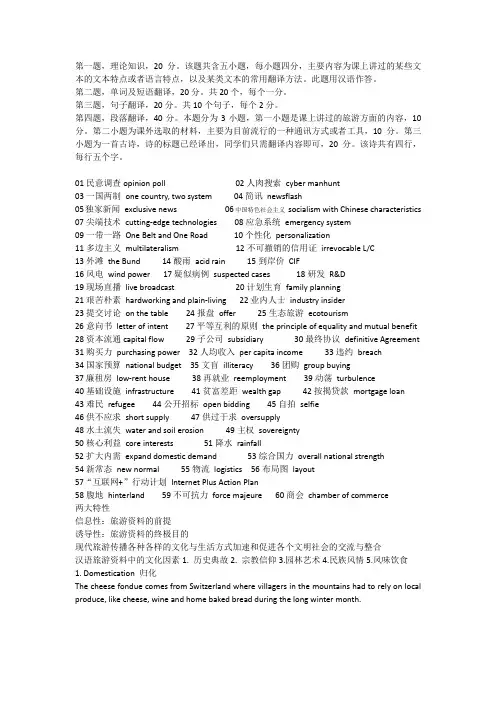
第一题,理论知识,20分。
该题共含五小题,每小题四分,主要内容为课上讲过的某些文本的文本特点或者语言特点,以及某类文本的常用翻译方法。
此题用汉语作答。
第二题,单词及短语翻译,20分。
共20个,每个一分。
第三题,句子翻译,20分。
共10个句子,每个2分。
第四题,段落翻译,40分。
本题分为3小题,第一小题是课上讲过的旅游方面的内容,10分。
第二小题为课外选取的材料,主要为目前流行的一种通讯方式或者工具,10分。
第三小题为一首古诗,诗的标题已经译出,同学们只需翻译内容即可,20分。
该诗共有四行,每行五个字。
01民意调查opinion poll 02人肉搜索cyber manhunt03一国两制one country, two system 04简讯newsflash05独家新闻exclusive news 06中国特色社会主义socialism with Chinese characteristics 07尖端技术cutting-edge technologies 08应急系统emergency system09一带一路One Belt and One Road 10个性化personalization11多边主义multilateralism 12不可撤销的信用证irrevocable L/C13外滩the Bund 14酸雨acid rain 15到岸价CIF16风电wind power 17疑似病例suspected cases 18研发R&D19现场直播live broadcast 20计划生育family planning21艰苦朴素hardworking and plain-living 22业内人士industry insider23提交讨论on the table 24报盘offer 25生态旅游ecotourism26意向书letter of intent 27平等互利的原则the principle of equality and mutual benefit 28资本流通capital flow 29子公司subsidiary 30最终协议definitive Agreement 31购买力purchasing power 32人均收入per capita income 33违约breach34国家预算national budget 35文盲illiteracy 36团购group buying37廉租房low-rent house 38再就业reemployment 39动荡turbulence40基础设施infrastructure 41贫富差距wealth gap 42按揭贷款mortgage loan43难民refugee 44公开招标open bidding 45自拍selfie46供不应求short supply 47供过于求oversupply48水土流失water and soil erosion 49主权sovereignty50核心利益core interests 51降水rainfall52扩大内需expand domestic demand 53综合国力overall national strength54新常态new normal 55物流logistics 56布局图layout57“互联网+”行动计划Internet Plus Action Plan58腹地hinterland 59不可抗力force majeure 60商会chamber of commerce两大特性信息性:旅游资料的前提诱导性:旅游资料的终极目的现代旅游传播各种各样的文化与生活方式加速和促进各个文明社会的交流与整合汉语旅游资料中的文化因素1. 历史典故2. 宗教信仰3.园林艺术4.民族风情5.风味饮食1. Domestication 归化The cheese fondue comes from Switzerland where villagers in the mountains had to rely on local produce, like cheese, wine and home baked bread during the long winter month.梁祝公园始建于公元397年,距今已有1600余年历史。
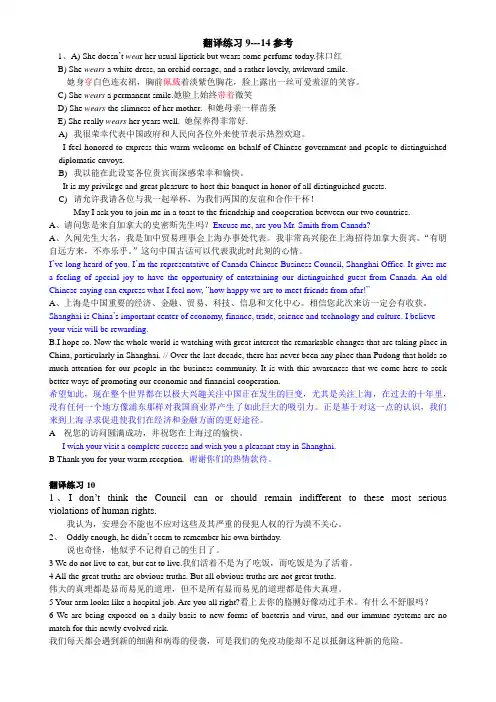
翻译练习9---14参考1、A) She doesn’t wea r her usual lipstick but wears some perfume today.抹口红B) She wears a white dress, an orchid corsage, and a rather lovely, awkward smile.她身穿白色连衣裙,胸前佩戴着淡紫色胸花,脸上露出一丝可爱羞涩的笑容。
C) She wears a permanent smile.她脸上始终带着微笑D) She wears the slimness of her mother. 和她母亲一样苗条E) She really wears her years well. 她保养得非常好.A)我很荣幸代表中国政府和人民向各位外来使节表示热烈欢迎。
I feel honored to express this warm welcome on behalf of Chinese government and people to distinguished diplomatic envoys.B)我以能在此设宴各位贵宾而深感荣幸和愉快。
It is my privilege and great pleasure to host this banquet in honor of all distinguished guests.C)请允许我请各位与我一起举杯,为我们两国的友谊和合作干杯!May I ask you to join me in a toast to the friendship and cooperation between our two countries.A、请问您是来自加拿大的史密斯先生吗?Excuse me, are you Mr. Smith from Canada?A、久闻先生大名,我是加中贸易理事会上海办事处代表。
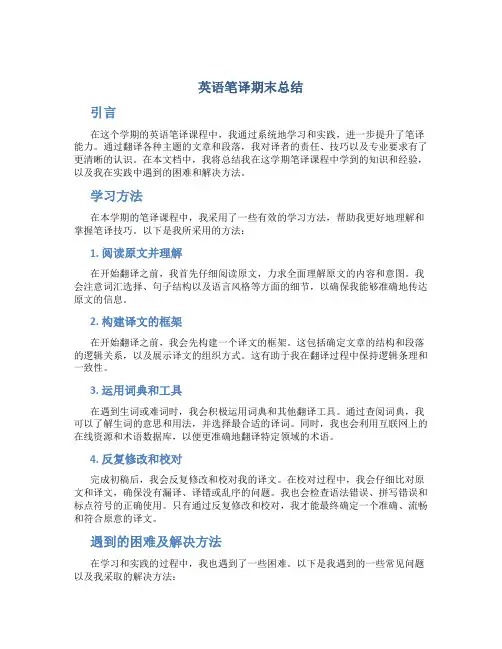
英语笔译期末总结引言在这个学期的英语笔译课程中,我通过系统地学习和实践,进一步提升了笔译能力。
通过翻译各种主题的文章和段落,我对译者的责任、技巧以及专业要求有了更清晰的认识。
在本文档中,我将总结我在这学期笔译课程中学到的知识和经验,以及我在实践中遇到的困难和解决方法。
学习方法在本学期的笔译课程中,我采用了一些有效的学习方法,帮助我更好地理解和掌握笔译技巧。
以下是我所采用的方法:1. 阅读原文并理解在开始翻译之前,我首先仔细阅读原文,力求全面理解原文的内容和意图。
我会注意词汇选择、句子结构以及语言风格等方面的细节,以确保我能够准确地传达原文的信息。
2. 构建译文的框架在开始翻译之前,我会先构建一个译文的框架。
这包括确定文章的结构和段落的逻辑关系,以及展示译文的组织方式。
这有助于我在翻译过程中保持逻辑条理和一致性。
3. 运用词典和工具在遇到生词或难词时,我会积极运用词典和其他翻译工具。
通过查阅词典,我可以了解生词的意思和用法,并选择最合适的译词。
同时,我也会利用互联网上的在线资源和术语数据库,以便更准确地翻译特定领域的术语。
4. 反复修改和校对完成初稿后,我会反复修改和校对我的译文。
在校对过程中,我会仔细比对原文和译文,确保没有漏译、译错或乱序的问题。
我也会检查语法错误、拼写错误和标点符号的正确使用。
只有通过反复修改和校对,我才能最终确定一个准确、流畅和符合原意的译文。
遇到的困难及解决方法在学习和实践的过程中,我也遇到了一些困难。
以下是我遇到的一些常见问题以及我采取的解决方法:1. 多义词的选择在翻译过程中,我经常遇到一个词有多个意思的情况。
为了选择合适的译词,我会通过查阅词典和参考其他翻译版本来学习不同上下文中的用法。
我也会通过理解整个句子的意思和上下文的逻辑关系,来判断哪个意思最符合原文的意思。
2. 翻译语言风格的转换英语和中文的语言风格有很大的差异。
在翻译过程中,我会注意转换语言风格,以使译文更符合目标读者的习惯和文化背景。
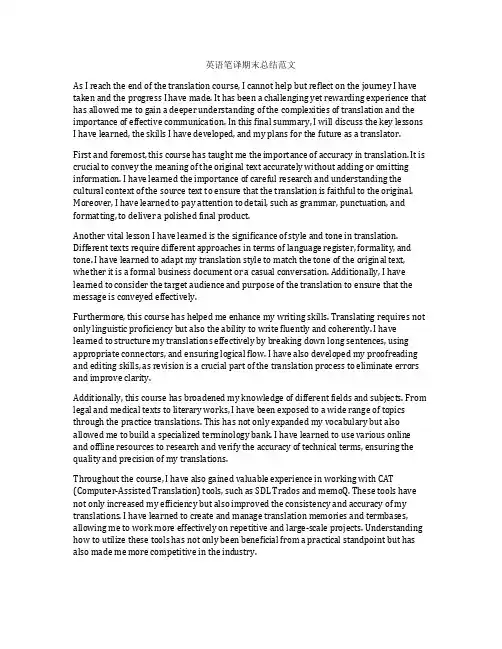
英语笔译期末总结范文As I reach the end of the translation course, I cannot help but reflect on the journey I have taken and the progress I have made. It has been a challenging yet rewarding experience that has allowed me to gain a deeper understanding of the complexities of translation and the importance of effective communication. In this final summary, I will discuss the key lessons I have learned, the skills I have developed, and my plans for the future as a translator.First and foremost, this course has taught me the importance of accuracy in translation. It is crucial to convey the meaning of the original text accurately without adding or omitting information. I have learned the importance of careful research and understanding the cultural context of the source text to ensure that the translation is faithful to the original. Moreover, I have learned to pay attention to detail, such as grammar, punctuation, and formatting, to deliver a polished final product.Another vital lesson I have learned is the significance of style and tone in translation. Different texts require different approaches in terms of language register, formality, and tone. I have learned to adapt my translation style to match the tone of the original text, whether it is a formal business document or a casual conversation. Additionally, I have learned to consider the target audience and purpose of the translation to ensure that the message is conveyed effectively.Furthermore, this course has helped me enhance my writing skills. Translating requires not only linguistic proficiency but also the ability to write fluently and coherently. I have learned to structure my translations effectively by breaking down long sentences, using appropriate connectors, and ensuring logical flow. I have also developed my proofreading and editing skills, as revision is a crucial part of the translation process to eliminate errors and improve clarity.Additionally, this course has broadened my knowledge of different fields and subjects. From legal and medical texts to literary works, I have been exposed to a wide range of topics through the practice translations. This has not only expanded my vocabulary but also allowed me to build a specialized terminology bank. I have learned to use various online and offline resources to research and verify the accuracy of technical terms, ensuring the quality and precision of my translations.Throughout the course, I have also gained valuable experience in working with CAT (Computer-Assisted Translation) tools, such as SDL Trados and memoQ. These tools have not only increased my efficiency but also improved the consistency and accuracy of my translations. I have learned to create and manage translation memories and termbases, allowing me to work more effectively on repetitive and large-scale projects. Understanding how to utilize these tools has not only been beneficial from a practical standpoint but has also made me more competitive in the industry.Looking ahead, I plan to continue improving my translation skills by actively seeking opportunities to practice. I aim to collaborate with other translators, join translation communities, and participate in translation contests to receive feedback and learn from experienced professionals. Additionally, I plan to specialize in specific fields, such as legal or technical translation, to further enhance my expertise and increase my marketability. I also intend to stay updated on industry news and trends, attend conferences, and take part in professional development courses to constantly improve my skills and stay ahead in a rapidly changing industry.In conclusion, the translation course has been an enriching experience that has equipped me with the knowledge, skills, and confidence to pursue a career as a translator. I am grateful for the lessons I have learned, the challenges I have overcome, and the growth I have experienced. I am excited about the future and confident in my abilities as a professional translator.。
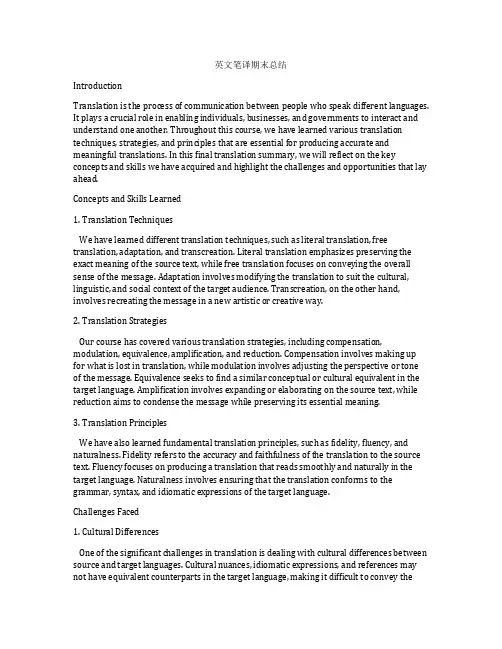
英文笔译期末总结IntroductionTranslation is the process of communication between people who speak different languages. It plays a crucial role in enabling individuals, businesses, and governments to interact and understand one another. Throughout this course, we have learned various translation techniques, strategies, and principles that are essential for producing accurate and meaningful translations. In this final translation summary, we will reflect on the key concepts and skills we have acquired and highlight the challenges and opportunities that lay ahead.Concepts and Skills Learned1. Translation TechniquesWe have learned different translation techniques, such as literal translation, free translation, adaptation, and transcreation. Literal translation emphasizes preserving the exact meaning of the source text, while free translation focuses on conveying the overall sense of the message. Adaptation involves modifying the translation to suit the cultural, linguistic, and social context of the target audience. Transcreation, on the other hand, involves recreating the message in a new artistic or creative way.2. Translation StrategiesOur course has covered various translation strategies, including compensation, modulation, equivalence, amplification, and reduction. Compensation involves making up for what is lost in translation, while modulation involves adjusting the perspective or tone of the message. Equivalence seeks to find a similar conceptual or cultural equivalent in the target language. Amplification involves expanding or elaborating on the source text, while reduction aims to condense the message while preserving its essential meaning.3. Translation PrinciplesWe have also learned fundamental translation principles, such as fidelity, fluency, and naturalness. Fidelity refers to the accuracy and faithfulness of the translation to the source text. Fluency focuses on producing a translation that reads smoothly and naturally in the target language. Naturalness involves ensuring that the translation conforms to the grammar, syntax, and idiomatic expressions of the target language.Challenges Faced1. Cultural DifferencesOne of the significant challenges in translation is dealing with cultural differences between source and target languages. Cultural nuances, idiomatic expressions, and references may not have equivalent counterparts in the target language, making it difficult to convey theintended meaning accurately. To overcome this challenge, translators need to be aware of the cultural context of both languages and opt for adaptation or transcreation techniques if necessary.2. Language AmbiguityLanguage ambiguity can pose challenges in translation, especially when words or phrases have multiple meanings or interpretations. It is crucial for translators to understand the context and disambiguate ambiguous terms to convey the intended meaning effectively. Utilizing translation strategies like modulation or compensation can help resolve ambiguities and produce a coherent translation.3. Time ConstraintsTranslating large volumes of text within tight deadlines is often a challenge for translators. The limited time available may affect the quality and accuracy of the translation. To overcome this challenge, effective time management and prioritization skills are essential. Translators should also consider utilizing translation tools or collaborating with teammates to streamline the translation process and meet the deadlines.Opportunities Ahead1. Professional GrowthAs we have learned throughout this course, translation is a skill that requires constant improvement and development. There are various opportunities for professional growth, such as attending translation conferences, participating in workshops, or obtaining certifications in specialized fields like legal or medical translation. Continued learning and exposure to different translation projects can enhance the translator's expertise and expand their career opportunities.2. Technology AdvancementsAdvancements in technology, such as machine translation, CAT tools, and language-specific software, have provided numerous opportunities for translators. These tools can streamline the translation process, enhance productivity, and improve the overall quality of translations. Staying updated with the latest translation technologies and adapting to their use can give translators a competitive edge in the industry.ConclusionTranslation is a dynamic and challenging field that requires a deep understanding of languages, cultures, and effective communication techniques. Through this course, we have acquired essential translation techniques, strategies, and principles that will aid us in producing accurate and meaningful translations. Nonetheless, we should remain open to continuous learning and adaptability to the ever-evolving nature of translation. Thechallenges and opportunities in the field are vast, and with dedication and perseverance, we can grow both professionally and personally.。
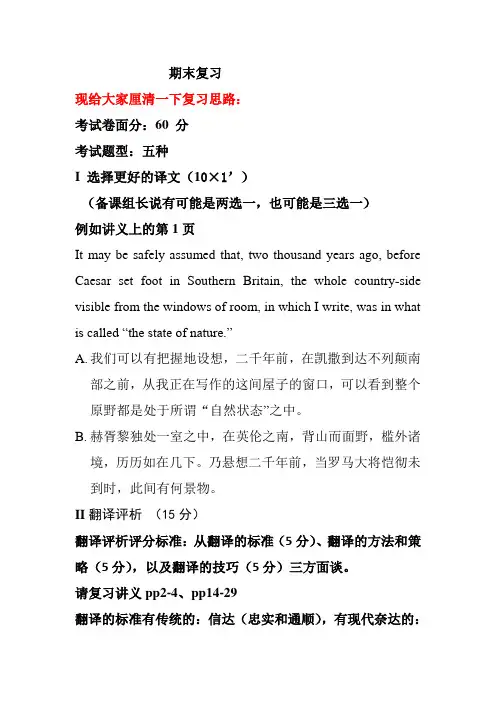
期末复习现给大家厘清一下复习思路:考试卷面分:60 分考试题型:五种I 选择更好的译文(10×1’)(备课组长说有可能是两选一,也可能是三选一)例如讲义上的第1页It may be safely assumed that, two thousand years ago, before Caesar set foot in Southern Britain, the whole country-side visible from the windows of room, in which I write, was in what is called “the state of nature.”A.我们可以有把握地设想,二千年前,在凯撒到达不列颠南部之前,从我正在写作的这间屋子的窗口,可以看到整个原野都是处于所谓“自然状态”之中。
B.赫胥黎独处一室之中,在英伦之南,背山而面野,槛外诸境,历历如在几下。
乃悬想二千年前,当罗马大将恺彻未到时,此间有何景物。
II翻译评析(15分)翻译评析评分标准:从翻译的标准(5分)、翻译的方法和策略(5分),以及翻译的技巧(5分)三方面谈。
请复习讲义pp2-4、pp14-29翻译的标准有传统的:信达(忠实和通顺),有现代奈达的:从形式对等—到动态对等—最后到功能对等翻译的基本方法:直译与意译翻译的基本策略(这是组长这样分的,其实都是翻译的方法):归化与异化翻译的技巧:词的技巧—词义的确立、词类转换译法、增加、省略、延伸、正反反正译法句子的技巧—三大从句的译法III 长句的翻译(3×5’)两个英语句子,一个汉语句子。
例如1:Ther e is nothing more disappointing to a hostess who has gone to a lot of trouble or expense than to have her guest so interested in talking politics or business with her husband that he fails to notice the flavor of the coffee, the lightness of the cake, or the attractiveness of the house, which may be her chief interest and pride.最令女主人失望的是,她花了许多心思或费用来招待客人,可是这位客人只顾津津有味地与她的丈夫谈政治、谈生意,却没注意到香喷喷的咖啡,松软的糕点,或房间内讲究的陈设,而这些却可能是她感到兴趣并引以自豪的主要所在。
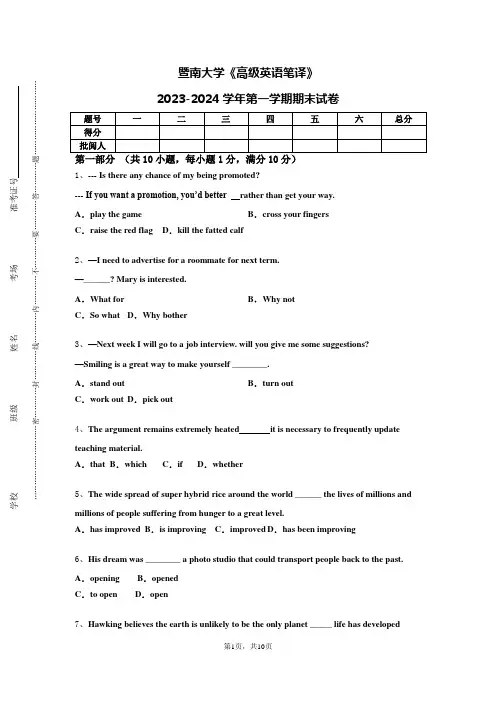
2023-2024学年第一学期期末试卷1、--- Is there any chance of my being promoted?--- If you want a promotion, you’d better rather than get your way.A.play the game B.cross your fingersC.raise the red flag D.kill the fatted calf2、—I need to advertise for a roommate for next term.—______? Mary is interested.A.What for B.Why notC.So what D.Why bother3、—Next week I will go to a job interview. will you give me some suggestions?—Smiling is a great way to make yourself ________.A.stand out B.turn outC.work out D.pick out4、The argument remains extremely heated it is necessary to frequently updateteaching material.A.that B.which C.if D.whether5、The wide spread of super hybrid rice around the world ______ the lives of millions andmillions of people suffering from hunger to a great level.A.has improved B.is improving C.improved D.has been improving6、His dream was ________ a photo studio that could transport people back to the past.A.opening B.openedC.to open D.open7、Hawking believes the earth is unlikely to be the only planet _____ life has developedA.that B.whyC.where D.whose8、No one believes his reasons for being late that he was caught in a traffic jam, _______ made him embarrassed.A.it B.which C.that D.why9、The engineer is thought to be capable and modest, so his promotion to manager is a popular _____.A.achievement B.appointment C.commitment D.employment10、Experience is a hard teacher because she ________ the test first, the lesson afterwards. A.gives B.has given C.was giving D.would give第二部分阅读理解(满分20分)阅读下列短文,从每题所给的A、B、C、D四个选项中,选出最佳选项。
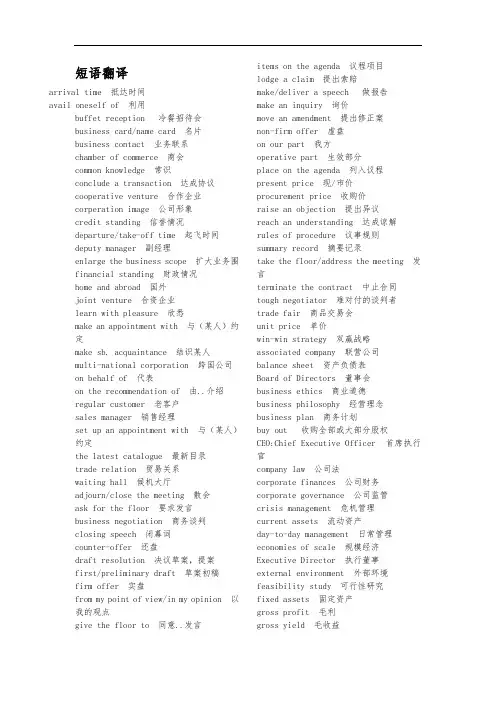
短语翻译arrival time 抵达时间avail oneself of 利用buffet reception 冷餐招待会business card/name card 名片business contact 业务联系chamber of commerce 商会common knowledge 常识conclude a transaction 达成协议cooperative venture 合作企业corperation image 公司形象credit standing 信誉情况departure/take-off time 起飞时间deputy manager 副经理enlarge the business scope 扩大业务围financial standing 财政情况home and abroad 国外joint venture 合资企业learn with pleasure 欣悉make an appointment with 与(某人)约定make sb. acquaintance 结识某人multi-national corporation 跨国公司on behalf of 代表on the recommendation of 由..介绍regular customer 老客户sales manager 销售经理set up an appointment with 与(某人)约定the latest catalogue 最新目录trade relation 贸易关系waiting hall 候机大厅adjourn/close the meeting 散会ask for the floor 要求发言business negotiation 商务谈判closing speech 闭幕词counter-offer 还盘draft resolution 决议草案,提案first/preliminary draft 草案初稿firm offer 实盘from my point of view/in my opinion 以我的观点give the floor to 同意..发言items on the agenda 议程项目lodge a claim 提出索赔make/deliver a speech 做报告make an inquiry 询价move an amendment 提出修正案non-firm offer 虚盘on our part 我方operative part 生效部分place on the agenda 列入议程present price 现/市价procurement price 收购价raise an objection 提出异议reach an understanding 达成谅解rules of procedure 议事规则summary record 摘要记录take the floor/address the meeting 发言terminate the contract 中止合同tough negotiator 难对付的谈判者trade fair 商品交易会unit price 单价win-win strategy 双赢战略associated company 联营公司balance sheet 资产负债表Board of Directors 董事会business ethics 商业道德business philosophy 经营理念business plan 商务计划buy out 收购全部或大部分股权CEO:Chief Executive Officer 首席执行官company law 公司法corporate finances 公司财务corporate governance 公司监管crisis management 危机管理current assets 流动资产day-to-day management 日常管理economies of scale 规模经济Executive Director 执行董事external environment 外部环境feasibility study 可行性研究fixed assets 固定资产gross profit 毛利gross yield 毛收益holding company 控股公司HQ:hearquarter 总部intangible assets 无形资产internal environment 部环境joint venture 合资企业joint ventures and alliances 合资与联盟listed company 上市公司management hierarchy 管理等级制度management skill 管理技巧managerial decision 管理决策MBO:management by objectives 目标管理net profit 净利润operation chart 经营(管理)表parent company 母公司parents and sisters company 母公司和姐妹公司personal assets 个人资产PLC:public limited company 公共股份private company 私人公司Purchasing Manager 采购经理quality assurance 质量保证raw material 原材料retained profit 留存利润ROI:return on investment 投资回报scientific management 科学管理self actualization 自我(价值)实现small and medium-sized enterprise 中小型企业sole trader 独资经营者state-owned enterprise 国有企业strategy committee 战略委员会take over 接管tangible assets 有形资产TQC:total quality control 全面质量控制trade association 贸易联盟单句翻译1.你可以在样本室里拿到这本最新的目录册。
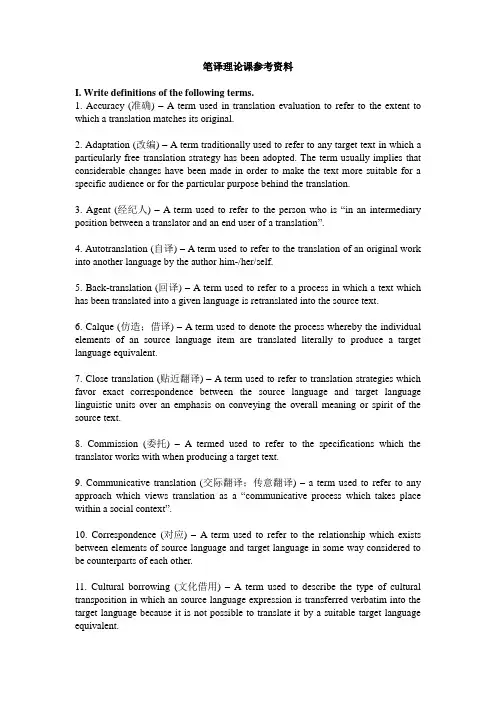
笔译理论课参考资料 I. Write definitions of the following terms. 1. Accuracy (准确) – A term used in translation evaluation to refer to the extent to which a translation matches its original.
2. Adaptation (改编) – A term traditionally used to refer to any target text in which a particularly free translation strategy has been adopted. The term usually implies that considerable changes have been made in order to make the text more suitable for a specific audience or for the particular purpose behind the translation.
3. Agent (经纪人) – A term used to refer to the person who is “in an intermediary position between a translator and an end user of a translation”.
4. Autotranslation (自译) – A term used to refer to the translation of an original work into another language by the author him-/her/self.
5. Back-translation (回译) – A term used to refer to a process in which a text which has been translated into a given language is retranslated into the source text.
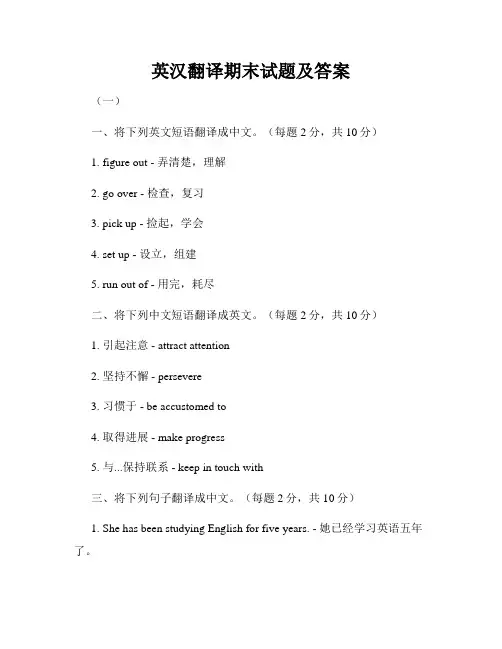
英汉翻译期末试题及答案(一)一、将下列英文短语翻译成中文。
(每题2分,共10分)1. figure out - 弄清楚,理解2. go over - 检查,复习3. pick up - 捡起,学会4. set up - 设立,组建5. run out of - 用完,耗尽二、将下列中文短语翻译成英文。
(每题2分,共10分)1. 引起注意 - attract attention2. 坚持不懈 - persevere3. 习惯于 - be accustomed to4. 取得进展 - make progress5. 与...保持联系 - keep in touch with三、将下列句子翻译成中文。
(每题2分,共10分)1. She has been studying English for five years. - 她已经学习英语五年了。
2. They will arrive at the airport at 10 o'clock. - 他们将于十点钟到达机场。
3. My brother is interested in playing basketball. - 我兄弟对打篮球很感兴趣。
4. We need to buy some vegetables for dinner. - 我们需要买些蔬菜来做晚餐。
5. I can't find my keys. Have you seen them? - 我找不到我的钥匙了,你看见了吗?四、将下列句子翻译成英文。
(每题2分,共10分)1. 你昨天去哪里了?- Where did you go yesterday?2. 这本书是我的,不是你的。
- This book is mine, not yours.3. 我妈妈正在做饭。
- My mother is cooking.4. 你明天几点起床?- What time will you get up tomorrow?5. 我们需要更多的时间来完成这个项目。
汉英笔译翻译期末总结As an essential part of language learning, translation serves as a bridge connecting different cultures and languages. In this translation end-of-term summary, I will reflect on my learning experience and discuss the challenges, strategies, and improvements in translation.1. Challenges in Translation(a) Cultural Differences: Translation is not just the conversion of words from one language to another, but also entails conveying the cultural connotations behind the text. The challenge lies in understanding the cultural nuances and accurately transmitting them to the target language.(b) Technical Terminology: Certain fields, such as medicine or engineering, have specialized terminology that poses a challenge for translators. To overcome this, extensive research and consultation with experts in the field are required.(c) Idioms and Proverbs: Idioms and proverbs are often deeply rooted in a specific language or culture, and translating them literally may result in a loss of meaning. Finding equivalent expressions in the target language that captures the original intent can be challenging.2. Translation Strategies(a) Contextual Understanding: Translating a text requires a deep understanding of the context in which it was written. Analyzing the overall meaning, tone, and purpose of the text helps in choosing appropriate translations.(b) Research: Extensive research on specialized terms and cultural references is essential for accurate translation. Utilizing dictionaries, glossaries, and online resources can aid in finding the most suitable equivalents.(c) Adaptation: Adapting and localizing the translation to fit the target audience is crucial. This involves adjusting cultural references, idioms, and phrasing to ensure the text resonates with the readers.3. Improvements in Translation(a) Vocabulary Enrichment: Expanding my vocabulary in both the source and target languages has been a significant improvement. By regularly reading and engaging with various texts, I have become more familiar with different registers and can choose the most appropriate words for a specific context.(b) Practice: Consistent practice has enhanced my translation skills. Engaging in translation exercises, participating in group discussions, and receiving constructive feedback have helped refine my techniques and identify areas for improvement.(c) Cultural Immersion: Exposing myself to different cultures and languages through literature, music, cinema, and travel has improved my understanding of cultural nuances and increased my sensitivity towards cultural differences in translation.4. Future Goals in Translation(a) Specialization: Building expertise in a specific field of translation, such as legal or medical, is a long-term goal. Acquiring in-depth knowledge of the specialized vocabulary and techniques required for accurate translation in these fields will enhance my abilities and career prospects.(b) Continuing Education: Attending workshops, seminars, and courses on translation and related subjects will provide opportunities to continue learning and stay updated with the latest developments in the field.(c) Collaboration: Collaborating with other translators and professionals in the industry will help broaden my perspectives, provide networking opportunities, and foster professional growth.In conclusion, translation is both challenging and rewarding. Throughout this term, I have improved my translation skills by understanding the cultural context, conducting thorough research, and practicing regularly. With continued effort and a focus on specialization, I am confident in furthering my translation abilities and making a meaningful contribution to cross-cultural communication.。
期末题型:I.Multiple Choices (20句10分)II.Error correction (20句10分)(Lesson 1—Lesson 5选自课后练习和课外练习)III.Reading comprehension (4篇20题,30分)(Lesson 1—Lesson 4课后阅读理解2篇+课外阅读理解2篇)IV.Translation of phrases and short sentences (C-E, E-C)(10个10分)V.Translation of long sentences (C-E)(5句10分)(选自课堂教学内容)VI.Translation of passages (E-C)(1篇10分)(选自课外材料)注:试卷满分80分,平时20分。
增译法就是法西斯国家本国的人民也被剥夺了人权。
Even the people in the fascist countries were stripped of their human rights.对不起,昨天病了,没来上课。
Sorry for my absence. But I was sick yesterday.三个臭皮匠,合成一个诸葛亮。
Three cobblers with their wits combined equal Zhuge Liang the mastermind.只许州官放火,不许百姓点灯。
While the magistrates were free to burn down house, the common people were forbidden to light lamps.(1)这个小男孩饭前都洗手,然后用餐巾纸擦干。
(2)跑了和尚跑不了庙。
(3)我们应该相信,全世界也好,中国也好,多数人是好人。
Keys:(1)The little boy always washes his hands before meals and then dries them with napkins.(2)The monk may run away, but the temple can‟t run away with him.(3)We should believe that in China, as everywhere else in the world, the majority of the people are good.省译法中国政府历来重视环境保护工作。
英语笔译期末总结Introduction:In this final review, we will summarize the knowledge and skills we have gained throughout this translation course. We will cover different topics, such as translation strategies, language structures, and cultural sensitivity. Additionally, we will reflect on our individual progress and areas for improvement. This final review aims to provide an overview of our achievements and enhance our translation abilities.Translation Strategies:During the course, we examined various translation strategies, including literal translation, free translation, and faithful translation. Literal translation aims to retain the structure and formality of the source text while free translation focuses on conveying the meaning and intent, often using more natural language. Faithful translation seeks to preserve the cultural implications and nuances of the source text. It is essential for translators to understand these strategies and choose the most appropriate one based on the context and purpose of the translation.Language Structures:We also explored different language structures and their impact on translation. For example, word order differences between English and Chinese can lead to challenges when translating sentence structures. Understanding idiomatic expressions and colloquialisms is another crucial aspect of translating accurately. It is essential to interpret the underlying meaning and find equivalent expressions in the target language.Cultural Sensitivity:Cultural sensitivity plays a vital role in translation. Translators need to be aware of cultural differences and adapt their translations accordingly. This includes understanding cultural norms, taboos, and practices. Misunderstandings can arise if cultural nuances are overlooked or misinterpreted. Therefore, proper research and cultural sensitivity are essential for producing high-quality translations.Individual Progress and Areas for Improvement:Throughout the course, each student has made progress in their translation skills. Upon reviewing our translations and receiving feedback from the professor, we have identified areas for improvement. These include vocabulary expansion, grammar proficiency, and stylistic choices. Additionally, actively seeking feedback from peers and professionals can help identify areas that require further improvement.Vocabulary expansion:Expanding our vocabulary is crucial for effective translation. By continuously learning and reviewing new words and phrases, we can enhance our ability to find suitable equivalents in the target language. Reading extensively in both the source and target languages can facilitate vocabulary expansion and help us become more confident translators.Grammar proficiency:Improving our grammar skills is essential for producing accurate translations. Grammatical errors can affect the clarity and coherence of the translated text. Regular practice and self-study can help strengthen grammar proficiency. Consulting grammar resources and seeking feedback from instructors can also aid in identifying and rectifying common grammatical mistakes.Stylistic choices:Developing a personal style is important for translators. Stylistic choices, such as using formal or informal language, can greatly impact the tone and effectiveness of a translation. Exploring different writing styles and practicing different approaches can help us find our own unique voice as translators.Conclusion:In conclusion, this translation course has provided us with valuable knowledge and skills. We have learned various translation strategies, language structures, and the importance of cultural sensitivity. Reflecting on our individual progress, we have identified areas for improvement, such as vocabulary expansion, grammar proficiency, and stylistic choices. By continuing to practice and seek feedback, we can further enhance our translation abilities. Overall, this course has laid the foundation for successful translation careers.。
Translating from English into Chinese. The greatest challenge of the 21st century will be to narrow the income gap between rich and poor nations, writers Martin Wolf. None of the readers of this column, has much chance of being alive at the end of this century. But suppose, for a moment, one was. What would give most pleasure? My answer is simple: that the economic opportunities now available to a small proportion of humanity would have become available to all. 马丁. 沃尔夫写道:21世纪最大的挑战将是缩小贫富国家之间的收入差距。 与该文同时代的读者也许没有一位能活到这个世纪末, 但是假如有一个人可以的话,那么他最有希望看到的情况会是什么呢? 答案很简单,那就是现在只有少数人才能得到的经济机会可以为所有人享有。 Two centuries ago, the lives of the great majority of human beings were, in the words of Thomas Hobbes, “nasty, brutish and short”. But then in a small island off the western end of Eurasia began what the great US economist, Simon Kuznets, called “modern economic growth”. By this he meant cumulative rises in real incomes per head. This was so much newer than what is today called the “new economy” that almost all the great economists failed to realize what was happening. Yet, according to Angus Maddison, the economic historian, since 1820 world population has increased 6-fold and world real output 50-fold. But the distribution of those huge gains has been highly unequal. At the beginning of the 19th century, the ratio of real incomes per head between the world’s richest and poorest countries was 3 to1. By 1900, it was 10 to 1. By 2000,it has risen to 60 to 1. 按照托马斯. 霍布斯的说法,在两个世纪前,大多数人的生活不仅“艰难、残酷,而且短暂”。 然而在欧亚大陆西端外的一个小岛上,开始出现了一种被美国伟大的经济学家西蒙.库兹涅茨称为“现代经济增长”的现象。 他所说的经济增长指的是人均实际收入的累计增长。 这种说法比当今的“新经济”概念还要新,以至于当时几乎所有权威的经济学家都未意识到所发生的一切。 依据经济历史学家安格斯.麦迪森的观点,1820年以来世界人口仅增长了6倍,而世界财富却实际增长了50倍。 但是,这些巨额财富却分配严重不均。 19世纪初,在世界最富和最穷国家之间,人均收入比是3:1. 到1900年,这一比率扩大为10:1,而到2000年,这种人均收入比率已经飙升到60:1.
Translating from English to Chinese. The letter of credit is the most widely used instrument of international banking. It has had a long and successful history as a means of facilitating international trade particularly during times of economic and political uncertainty. The letter of credit is the bank instrument that assures the person selling merchandise of payment if he makes the agreed-upon shipment. On the other hand, it also assures the buyer that he is not required to pay until the seller ships the goods. It provides the buyer and the seller with mutual protection in dealing with each other. 信用证是国际银行业务中最广泛使用的凭证。信用证由来已久,卓有成效,是促进国际贸易的一种手段,在经济和政治不稳定时期尤其如此。当买卖双方签定合同时,一笔国际交易就开始了。合同写明这项交易的全部内容:商品名称、价格、交货日期、运输方法以及商品的颜色、规格等细节。 An international trading transaction begins when a buyer and a seller sign a contract that records all the elements of the transaction: the merchandise, price, delivery date, and method of shipment, as well as specifics of color, size and so on. 协议达成后,买卖双方必须安排支付问题。买方想在付款前拿到货物,而卖方则想在交货之前获得货款。由于彼此往往不甚了解,所以买卖双方对交易都存有某种戒心。 Having worked out an agreement, the buyer and seller must arrange payment. The buyer will want possession before paying, and the seller will want payment before making delivery. Since each party oftern has incomplete knowledge of the other, there is a certain caution to their dealings. At this point, the letter of credit can be extremely useful. The buyer requests his bank to issue a letter of credit in favor of the seller. Assuming that the credit risk is acceptable to the bank, it issues its letter of credit. The letter says, in essence, to the seller;” We, the bank, promise that we will pay you when you submit certain documents proving that you have made the agreed-upon shipment.” The letter of credit also protects the buyer, for he knows that he will not be called upon for payment by his bank until the evidence shows that the shipment has actually been effected. 协议达成后,买卖双方必须安排支付问题。 买方想在付款前拿到货物,而卖方则想在交货前获得贷款。 由于彼此往往不甚了解,所以买卖双方对交易都存有某种戒心。 信用证在这一点上极为有用。买方就要求银行给卖方开具一张信用证。如果银行愿意承担风险,它就发放信用证。信用证实际上是告诉卖方;“当你出示凭证证明货物已按协议装运完毕,我行答应付款”。信用证同时还保护着买方,因为买方知道,在有凭证证明货物确已装运后,银行才会要求他付款。
Translating from English into Chinese. The most important drawback of the AMA is that it takes a simplistic and incomplete view of the marketing process. According to the definition, marketing is construed to occur from marketer to consumer. The flow is in one direction . Such a viewpoint overlooks how marketing actually occurs in the real world. The process is not limited to a one-way flow or sequence from marketer to consumer. Rather, the vast majority of marketing activities involves interaction between seller and buyer. As a consequence, a number of marketers now view marketing in terms of exchange relationships. 该定义最大的缺点在于,它对营销过程的理解过于简单、片面。 依据它的定义,营销被解释为是从销售商到消费者的单向的业务过程。这种观点没有考虑到显示中的实际情况。市场营销的过程不仅仅是从销售商到消费者单向流动的过程或顺序,绝大多数市场营销活动都会涉及买方与卖方的相互作用。 所以有一些企业营销人员会从交换关系这个角度去看待市场营销。 The field of marketing is quite broad in scope and overlaps with and draws upon many related subject areas. As we may discover, marketers continually borrow